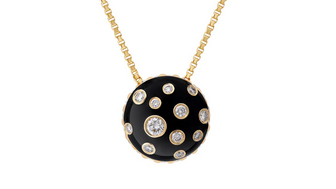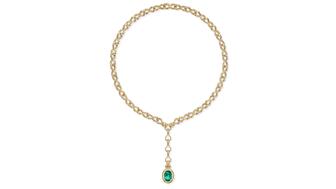Why Inclusivity Is Important in Diamond Traceability
As the importance of mine-to-market grows, some worry about its feasibility for all the diamond industry’s players.

For the diamond market, it has led to a switch.
An industry that once tried to steer the conversation away from machinery and digging, lest it detract from the product’s sex appeal, is now talking non-stop about where diamonds come from and the good they do, and it is relying on technology like blockchain to document it.
For many, the idea of increased transparency in the supply chain is inherently a good thing.
“I think all of us, certainly anybody with any kind of a social conscience, understands that we need to take great care that the diamonds don’t come from sources that are bad actors,” said Jeff Fischer.
Fischer is president of manufacturing firm Fischer Diamonds Inc. and, among other roles, is a past president of both the International Diamond Manufacturers Association (IDMA) and the Diamond Manufacturers and Importers Association of America (DMIA).
A system has been put into place, he said, to create a safety net around “the vast majority of goods” and ensure those goods—and only those goods—are what make it through the system.
This includes processes to ensure diamonds and diamond mining are doing no harm, and stressing the importance of due diligence.
But from the good has arisen concerns about the possible unintended consequences of traceability for the market’s smaller players.
Small-Scale Miners and the Midstream
Since many processes and systems created for traceability rely heavily on technology, questions of capacity and feasibility arise.
It’s estimated that around 20 percent of the global diamond supply comes from artisanal and small-scale miners.
On one hand, the technology could provide an opportunity for some diamond-producing countries to learn more and increase their market share as they participate in the technological revolution, said Stephane Fischler.
A lifelong diamantaire, Fischler is a partner in Fischler Diamonds, as well as a founding member and former president of the World Diamond Council (WDC) and vice president at the Diamond Development Initiative (DDI), which merged with Resolve last year.
On the other, he notes: “Artisanal miners do lack most of the capacity to deliver on the technology to assure provenance. So while it’s good and it’s something that will grow, we do need to be very, very careful and very honest as to what the motives are and what the potential impact could be.”
He also pointed out that when the market pushes origin as the “holy grail” and creates conditions upon which consumers would or would not buy a diamond, it can make consumers risk-averse and push them to decide against buying diamonds from those who may need it most.
“Artisanal miners do lack most of the capacity to deliver on the technology to assure provenance. So while it’s good and it’s something that will grow, we do need to be very, very careful and very honest as to what the motives are and what the potential impact could be.” — Stephane Fischler, Fischler Diamonds
This works against what’s being done in the industry to derisk the ASM sector—groups like the Organisation for Economic Co-operation and Development and its due diligence framework, and projects like Resolve and DDI’s Maendeleo Diamond Standards for the artisanal mining sector.
Further downstream, traceability processes and systems also could have repercussions for those in the manufacturing link of the diamond supply chain.
Fisher raised concerns about the “untold amounts of merchandise that works its way through the system in a route that makes many more stops,” as well as the vast amount of material already in the pipeline, begging the question: What about those diamonds?
Not having their specifics locked in a blockchain already doesn’t mean they didn’t follow a fully viable and trusted path to market, especially given the regulations and stringent legislation linked to diamond trading.
Another obstacle is the tracking of melee, especially given the size of the diamond melee market and how much of it is used in jewelry.
While it might be feasible to follow larger polished stones, as they follow a more straightforward path from mine to market, smaller goods from various origins are often mixed together to create the required assortments.
This means that, “for 80 percent of the goods, I would say there is no way this thing of origin is feasible,” Fischler said.
In a recent editorial in the IDMA newsletter, however, consultant Ya’akov Almor presented a different point of view—that tracing melee can and should be done, to protect prices and, ultimately, the industry.
While acknowledging tracking melee would “demand increased investments in organizational structures, demand changes in work practices, and call for effective marketing and sales methods,” he argues the benefits of such changes would outweigh the obstacles.
The benefits include, Almor wrote, the industry’s ability to make origin and provenance part of its marketing activities, and creating more added value and, thereby, higher prices throughout the entire supply chain.
The Bigger Picture
The topics of sustainability and ethical sourcing tend to be whittled down to a single aspect, traceability—the ability to track a stone from where it was extracted from the earth to the showcase were it ultimately ends up.
But in reality, the conversation is much more expansive.
Ethical sourcing is not only about origin, Fischler said, but the stone’s whole story.
It’s about not only how the diamond was processed, but whether players involved have a positive impact on their communities and the people handling the diamonds did no harm in the process, among other similar questions.
Responsible Jewellery Council Executive Director Iris Van der Veken shared a similar thought.
“We cannot see sustainability in an isolated manner,” she told National Jeweler.
“It is important to have management systems in place that cover human rights, labor rights, health and safety, environment, product integrity and disclosure. In other words, all the processes involved in mining, cutting and polishing, casting, and setting into jewelry need to be in the scope.”
Feriel Zerouki, senior vice president of international relations and ethical initiatives at the De Beers Group and WDC vice president, said this is why programs like De Beers’ Best Practice Principles are “also such an important part of the equation” and why De Beers shares information about performance, impact and goals in the areas of sustainability and social purpose.
To help aid in the traceability, mine-to-market conversation, De Beers Group launched its own blockchain platform, Tracr, in 2018.
Zerouki said the company is currently registering about 15 percent of its production on the platform.
In addition, De Beers Jewellers, the company’s chain of retail stores, recently introduced its first collection using only diamonds fully tracked and registered on Tracr, called “1888 Master Diamonds.”
The world’s other main diamond mining company, Alrosa, joined Tracr in 2018 and introduced an “electronic passport” for its diamonds at the 2019 Las Vegas trade shows.
Beyond Traceability
The industry has myriad mechanisms in place designed to provide consumers and stakeholders with assurances their goods are responsibly sourced.
“The industry has to be inclusive. It’s really important when you look at our supply chain in jewelry; there are thousands of small family businesses that depend on that. Where the role of organizations like ours also comes in is to see that we bring the right stakeholders around the table.” — Iris Van der Veken, Responsible Jewellery Council
But as their importance continues to grow, the industry needs to make sure these systems are inclusive, rather than excluding smaller players because they are too cumbersome and/or expensive—concerns both Fischer and Fischler raised.
Van der Veken feels the same way.
“The industry has to be inclusive. It’s really important when you look at our supply chain in jewelry; there are thousands of small family businesses that depend on that. Where the role of organizations like ours also comes in is to see that we bring the right stakeholders around the table.
“And if we agree on what the processes are or how the standard is implemented with support of technology, then we need to see that those systems are practical and accessible.”
With the understanding that not every company has the time or money to become an RJC member, the organization has made resources available online for free, like video training sessions and online events, as well as guidance walk-throughs. It also is slated to launch a CSR toolkit next month.
And since traceability methods and the information companies will provide is an evolving area, “ensuring industry participants are able to access and participate in the programs that best suit their needs will be important,” Zerouki said.
She said De Beers will make this a key focus as it develops programs to provide the origin and pathway of every diamond it produces and sells by 2030, one of a dozen sustainability goals announced late last year as part of “Building Forever.”
Another vital component in the conversation—the retailer. The more information and assurance the retailers can provide, the better, Zerouki said.
“Ultimately, diamonds are a consumer-facing product, which means everyone in the supply chain has an ongoing role to play in meeting continually evolving stakeholder expectations.”
For Fischler, it’s about making sure that messaging in front of consumers is well-rounded and doesn’t detract from the “magic” of the product by throwing a lot of data their way.
“I see some starting to push a lot of information toward the consumer, whether it’s about origin, whether it’s grading provided by labs, and so on, for a product that is 100 percent emotion,” he said.
“And I’m a little bit skeptical about using this origin/provenance story to start to push a product toward the consumer, risking, I would say, diluting a lot of the emotional content.”
The Latest

She is remembered as an artist who loved her craft and was devoted to her faith, her friends, and her family.

The polka dot pattern transcends time and has re-emerged as a trend in jewelry through round-shaped gemstones.

Vanessa Hickman, 49, allegedly sold a diamond bracelet that was mistakenly sent to her home.

How Jewelers of America’s 20 Under 40 are leading to ensure a brighter future for the jewelry industry.

GIA’s former president and CEO was presented with the Richard T. Liddicoat Award for Distinguished Achievement.


Social media experts spoke about protecting brand reputation through behaving mindfully online.

In 2026, the three will come together as “House of Brands,” with Gallet sold in Breitling stores and Universal Genève sold separately.

Roseco’s 704-page catalog showcases new lab-grown diamonds, findings, tools & more—available in print or interactive digital editions.

The second drop, which includes more Elphaba-inspired pieces from additional designers, will continue to benefit nonprofit Dreams of Hope.

Second-generation jeweler Sean Dunn has taken on the role.

Amber Pepper’s main focus will be on digital innovation and engaging younger consumers.

The lariat necklace features a 4.88-carat oval-cut Zambian emerald in 18-karat yellow gold.

A 43-carat sapphire brooch from the Vanderbilt collection was the top lot of the Geneva sale.

Rau is a fourth-generation art and antique dealer from M.S. Rau gallery whose first jewelry collection merges artifacts with modern design.

Former De Beers sustainability leader Purvi Shah will take over the role in February 2026.

La Joux-Perret is based in La Chaux-de-Fonds, Switzerland, and makes solar quartz as well as mechanical watch movements.

She previously taught at Gem-A and is the founder of The Gem Academy.

The British actress and her daughter modeled pieces from the brand’s new “Palette” capsule for its “Once Upon a Time” holiday campaign.

Plus, the tech giant shares the steps retailers should take if they believe they’re a victim of a review extortion scam.

Danny and Gaby Shaftel are now Shaftel Diamonds’ CEO and chief operating officer, respectively.

The jewelry manufacturer’s seasonal offering features its new “Melodie” bangles, as well as mini stud earrings and layering pieces.

With more than 140 activations taking place in New York City now through Nov. 23, these 12 events are can’t-miss moments.

The Chapter 11 filing follows the resignation of CEO Moti Ferder, who stepped down after an investigation into the company’s finances.

The artwork is part of an exhibition featuring works by Kathleen Ryan, an artist known for her gemstone-studded rotting fruit sculptures.

Mark Wall, president and CEO of Canadian mining company Mountain Province Diamonds, will vacate his position next month.

Faustino Alamo Dominguez and his son, 25-year-old Luis Angel Alamo, were gunned down following an armed robbery at their jewelry store.

Tiffany & Co. veteran Jeffrey Bennett has stepped into the role.






























